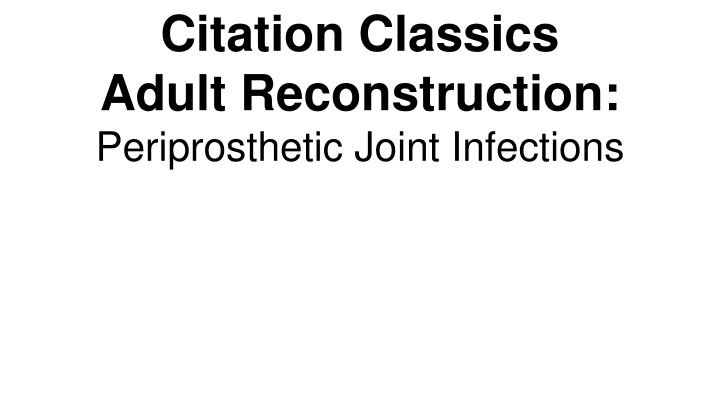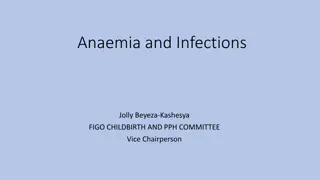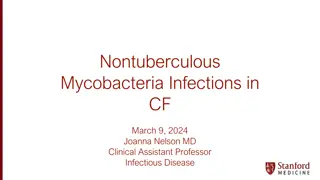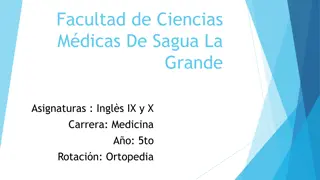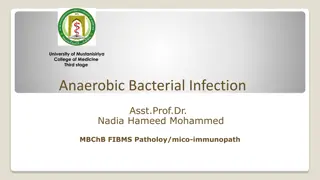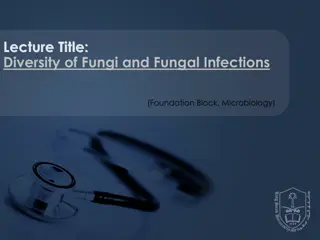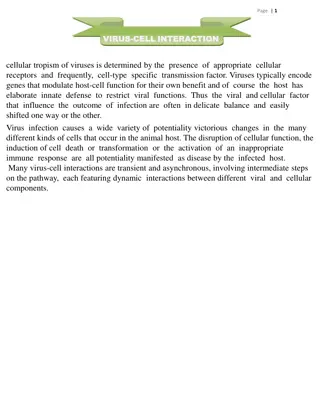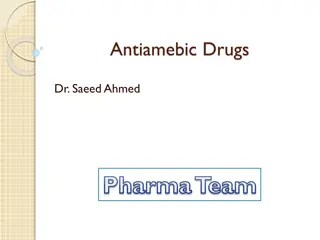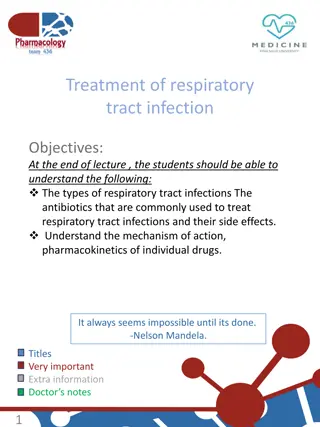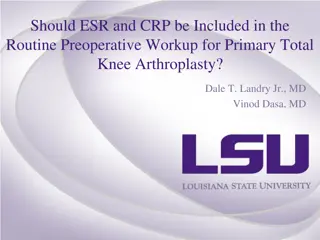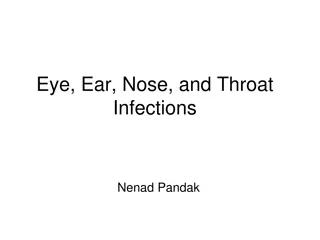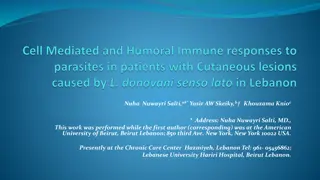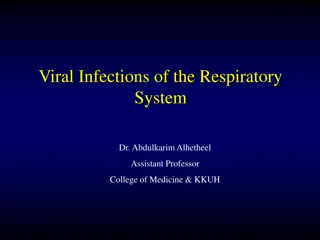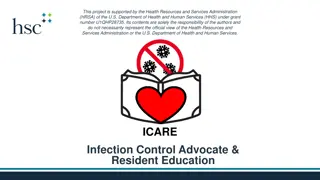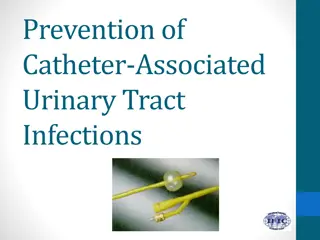Advanced Criteria for Diagnosing Periprosthetic Joint Infections
Cutting-edge research proposes an evidence-based scoring system for defining periprosthetic joint infections (PJIs) after total joint arthroplasty. The study presents externally validated criteria and compares them with previous methods. Results show high sensitivity and specificity, marking a significant advancement in PJI diagnosis. Recommendations and limitations are discussed for implementation in clinical settings.
Download Presentation

Please find below an Image/Link to download the presentation.
The content on the website is provided AS IS for your information and personal use only. It may not be sold, licensed, or shared on other websites without obtaining consent from the author.If you encounter any issues during the download, it is possible that the publisher has removed the file from their server.
You are allowed to download the files provided on this website for personal or commercial use, subject to the condition that they are used lawfully. All files are the property of their respective owners.
The content on the website is provided AS IS for your information and personal use only. It may not be sold, licensed, or shared on other websites without obtaining consent from the author.
E N D
Presentation Transcript
Citation Classics Adult Reconstruction: Periprosthetic Joint Infections
The 2018 Definition of Periprosthetic Hip and Knee Infection: An Evidence-Based and Validated Criteria Javad Parvizi, MD, Timothy L. Tan, MD, Karan Goswami, MD, Carlos Higuera, MD, Craig Della Valle, MD, Antonia F. Chen, MD, MBA, Noam Shohat, MD Journal of Arthroplasty 2018
Background Diagnosing PJI is difficult and there s no one-stop-shop test Previous MSIS endorsed consensus definition (2013) sinus tract, 2 positive cultures, or 3/5 criteria serum inflammatory markers, synovial cell count, PMNs, positive histology, and single culture positive Purpose: 1. Generate weight-adjusted scoring system for defining PJIs 2. Externally validate 3. Compare the new scoring system vs the previous
Methods Retrospective review of all revision TKA and THA cases from 3 centers (2001-2016) Exclusions: no serum labs, no aspiration, acute PJIs, did not meet MSIS major criteria
Results Sensitivity 97.7 Specificity 99.5
Conclusions First externally validated, evidence-based criteria for diagnosing PJI after TJA More useful during the preoperative phase of diagnosis Gray area Utility of next-generation sequencing Limitations Implementation in acute PJIs Tool for diagnosis vs guide for testing Combined hips and knees
Two-Stage Exchange Protocol for Periprosthetic Joint Infection Following Total Knee Arthroplasty in 245 Knees without Prior Treatment for Infection Stephen M. Petis, MD, FRCSC, Kevin I. Perry, MD, Tad M. Mabry, MD, Arlen D. Hanssen, MD, Daniel J. Berry, MD, and Matthew P. Abdel, MD The Journal of Bone and Joint Surgery 2019
Background PJI is a devastating outcome following TKA 2-stage exchange has been considered gold-standard treatment Prior survival rates 80-95% (however confounded) Purpose: To determine long-term reinfection rates for TKAs complicated by PJI without previous infection treatment
Methods Retrospective review, single institution, TKAs treated with 2-stage revision (1991-2006) 630 cases exclusions 245 cases Diagnosis of PJI via Musculoskeletal Infection Society criteria Surgical Technique: --Implant removal, I&D, antibiotic spacer --6 weeks of IV antibiotics --5 weeks of antibiotic holiday --Re-implantation Follow-up 3 months, 1 year, 2 years, 5 years, and every 5 years
Results Reinfection: 4.1% at 1 years 9.5% at 2 years 14.2% at 5 years 16.4% at 10 years 16.9% at 15 years Last follow-up 41 knees re-infected KSS improved from 45 at PJI diagnosis to 76 at 10 years Risk factors predictive of reinfection: BMI 30 Previous revision surgery McPherson host grade of C
Conclusions 15 year cumulative incidence of reinfection after PJI treatment with 2- stage protocol was 17% Obesity, history of revision surgery, and poor host were predictors Strengths Well defined cohort with 15 years of cumulative follow-up Limitations Retrospective (standardization), single institution (generalizability)
Two-stage Exchange Arthroplasty for Infected Total Knee Arthroplasty: Predictors of Failure S. M. Javad Mortazavi MD, David Vegari MD, Anthony Ho BA, Benjamin Zmistowski BS, Javad Parvizi MD, FRCS Clinical Orthopedics and Related Research, 2011
Background Two stage exchange is the gold-standard treatment for PJIs Literature cites variable effectiveness as 67-91% eradication of infection after treatment Variability may be affected by different factors patient and surgeon factors Purpose: Determine rate of PJI eradiaction after 2-stage exchange Assess variables that may influence outcomes after 2-stage exchange
Methods Retrospective review, single institution database, patients who underwent 2- stage exchange from 1997-2007 117 patients 2-stage exchange protocol: 1. Resection, debridement, antibiotic-spacer 2. IV antibiotics 3. Antibiotic holiday and clinical assessment 4. Reimplanation Rate of recurrence or failure of treatment of PJI = needing further treatment for PJI Assessed factors that may predict recurrent or failure of treatment
Results 28% required subsequent treatment for recurrent infection Predictors of failure (UVA) 1. Intraop purulence/sinus tract during 1st stage (p=0.02) 2. Positive tissue culture (p=0.02) Predictors of failure (MVA) 1. Negative culture [OR 4.5, p=0.02] 2. Methicillin-resistant organisms cultured [OR, 2.8, p=0.12] 3. Increased operative time at reimplantation [OR, 1.01, p=0.05]
Conclusions A combination of factors should be assessed before re-implantation Non-predictors interestingly included ESR and CRP interstage point of revision *Important to think about it before re-implantation Comorbidities that previously may have presumably increased rate of failure i.e. DM, obesity, CAD did not associate with treatment failure Limitations Single tertiary referral center lends itself to selection bias Retrospective missing data Limited sample size may not have identified all significant variables Multiple surgeons with variable protocols
Swab Cultures Are Not As Effective As Tissue Cultures for Diagnosis of Periprosthetic Joint Infection Aggarwal et al, (Rothman group) CORR 2013 Prospective cohort study comparing effectiveness of swab cultures vs. tissue samples in diagnosing PJIs
Background Cx negative PJI remains an issue and makes abx tx more challening No consensus on the best way to obtain samples Swab Cultures Benefits: easy and cost effective Swab Culture Issues: contamination, decreased volume
Methods Prospective study, 117 revision arthroplasties from 2011-2012. 74 total hip and 43 total knee revisions. 30 septic, 87 aseptic revisions. Modified MSIS criteria (pre-2019) were used to dx PJI 3 tissue and 3 swab samples collected. Results of cultures: Sensitivity, Specificity, PPV, NPV
Results More false positives and false negatives in culture swabs Sensitivity, specificity, PPV, NPV higher for tissue culture Positive tissue culture associated with true diagnosis of PJI compared to swab Most common pathogens grown
Conclusion Periprosthetic tissue cultures are better at identifying microorganisms compared to swab cultures Limitations: Cultured for 5 days, possible inflation of false negatives, truly aseptic, no consensus definition of PJI Future: Cost effectiveness and efficiency of diagnostic methods
Increased risk of PJI following primary TKA/THA with the use of alternative antibiotics to cefazolin Wyles et al (Mayo), JBJS 2019 Retrospective cohort of 29.6k TJAs done at single institution
Background Cefazolin/cephlosporin prophylaxis for TKA and THA. Minimal side effects, excellent coverage for organisms seen in PJIs Vancomycin or clindamycin are alternatives in case of allergy or MRSA (vancomycin) Cross reactivity between penicillin and cephalosporin in small, but higher than non-penicillin reactors Retrospective Cohort: Characterize abx choices for perioperative prophylaxis of primary THA/TKA Assess efficacy of preoperative antibiotic allergy testing Determine rates of PJI based on periop antibiotic
Methods Retrospective review of 29.6k THA/TKA (22.7k patients) between 2004-2017 Allergy Testing Registry data was available for 2.5k pts (11.5%) Database data were combined to evaluate allergy consultation outcomes, perioperative antibiosis, and infection free survivorship PJI was documented as a complication by third-party reviewers if pt diagnosed with PJI by physician or has a documented positive culture from intraoperative or aspirated synovial fluid specimen MRSA colonization was determined based on preoperative nasal swab culture results
Results 28,174 (94.9%) of arthroplasties received Cefazolin, 1,521 (5.1%) received non-cefazolin abx (primarily vanc or cinda) Positive MRSA colonization was more frequent in TJA receiving non- cefazolin abx Infection free survivorship was higher in the cefazolin group vs non- cefazolin group at all time points out to 10 years Increased rate of PJI observed in non-cefazolin group was not attributable to high MRSA colonization prevalence as none of the 38 PJI grew MRSA on culture Allergy consultation increased proportion of patients receiving Cefazolin by 27%.
Conclusion Lower rates of PJIs when Cefazolin was used for surgical prophylaxis in primary TKA and THAs Preoperative allergy testing increased Cefazolin usage to over 80% of patients tested Authors recommend perioperative testing and clearance for all patient presenting with penicillin and cephalosporin allergies in effort to positively influence a modifiable risk factor for PJI (abx choice) Strengths: Large sample size, single institution with individual patient level data Limitations: Retrospective Cohort Study Unknown causative organism/susceptibilities in PJIs, unknown timing of administration of antibiotics, applying this data for other institutions who may be using other first-generation cephalosporin ppx
